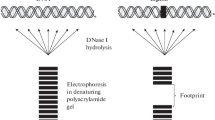Abstract
Defining the precise promoter DNA sequence motifs where nuclear receptors and other transcription factors bind is an essential prerequisite for understanding how these proteins modulate the expression of their specific target genes. The purpose of this chapter is to provide the reader with a detailed guide with respect to the materials and the key methods required to perform this type of DNA-binding analysis. Irrespective of whether starting with purified DNA-binding proteins or somewhat crude cellular extracts, the tried-and-true procedures described here will enable one to accurately access the capacity of specific proteins to bind to DNA as well as to determine the exact sequences and DNA contact nucleotides involved. For illustrative purposes, we primarily have used the interaction of the androgen receptor with the rat probasin proximal promoter as our model system.
Access this chapter
Tax calculation will be finalised at checkout
Purchases are for personal use only
Similar content being viewed by others
References
Lonard, D. M., Lanz, R. B., and O'Malley, B. W. (2007) Nuclear receptor coregulators and human disease. Endocr Rev 28, 575–587.
Kasper, S., Rennie, P. S., Bruchovsky, N., Sheppard, P. C., Cheng, H., Lin, L., Shiu, R. P., Snoek, R., and Matusik, R. J. (1994) Cooperative binding of androgen receptors to two DNA sequences is required for andro-gen induction of the probasin gene. J Biol Chem 269,31763–31769.
Rennie, P. S., Bruchovsky, N., Leco, K. J., Sheppard, P. C., McQueen, S. A., Cheng, H., Snoek, R., Hamel, A., Bock, M. E., and Mac-Donald, B. S., et al. (1993) Characterization of two cis-acting DNA elements involved in the androgen regulation of the probasin gene. Mol Endocrinol 7,23–36.
Yeung, L. H., Read, J. T., Sorenson, P., Nelson, C. C., Jia, W., and Rennie, P. S. (2003) Identification and characterization of a prostate-specific androgen-independent protein-binding site in the probasin promoter. Biochem J 371,843–855.
Gao, N., Zhang, J., Rao, M. A., Case, T. C., Mirosevich, J., Wang, Y., Jin, R., Gupta, A., Rennie, P. S., and Matusik, R. J. (2003) The role of hepatocyte nuclear factor-3 alpha (Forkhead Box A1) and androgen receptor in transcriptional regulation of prostatic genes. Mol Endocrinol 17,1484–1507.
Zhang, J., Thomas, T. Z., Kasper, S., and Matusik, R. J. (2000) A small composite pro-basin promoter confers high levels of prostate-specific gene expression through regulation by androgens and glucocorticoids in vitro and in vivo. Endocrinology 141,4698–4710.
Yu, D., Scott, C., Jia, W. W., De Benedetti, A., Williams, B. J., Fazli, L., Wen, Y., Gleave, M., Nelson, C., and Rennie, P. S. (2006) Targeting and killing of prostate cancer cells using lentiviral constructs containing a sequence recognized by translation factor eIF4E and a prostate-specific promoter. Cancer Gene Ther 13,32–43.
Rennie, P.S., and Cheng H. unpublished data.
Reid, K. J., and Nelson, C. C. (2001) Improved methylation protection-based DNA footprinting to reveal structural distortion of DNA upon transcription factor binding. Bio-techniques 30,20–22.
Reid, K. J., Hendy, S. C., Saito, J., Sorensen, P., and Nelson, C. C. (2001) Two classes of androgen receptor elements mediate coop-erativity through allosteric interactions. J Biol Chem 276,2943–52.
Read, J. T., Rahmani, M., Boroomand, S., Allahverdian, S., McManus, B. M., and Ren-nie, P. S. (2007) Androgen receptor regulation of the versican gene through an androgen response element in the proximal promoter. J Biol Chem 282,31954–31963.
Acknowledgments
The authors acknowledge the work of Kimberly J. Reid, Lillian H. Yeung, and Pernille Sorenson in the development of these techniques in our lab.
This work was supported by grants from the Terry Fox Foundation and the National Cancer Institute of Canada.
Author information
Authors and Affiliations
Editor information
Editors and Affiliations
Rights and permissions
Copyright information
© 2009 Humana Press, a part of Springer Science+Business Media, LLC
About this protocol
Cite this protocol
Read, J.T., Cheng, H., Hendy, S.C., Nelson, C.C., Rennie, P.S. (2009). Receptor-DNA Interactions: EMSA and Footprinting. In: McEwan, I.J. (eds) The Nuclear Receptor Superfamily. Methods in Molecular Biology™, vol 505. Humana Press. https://doi.org/10.1007/978-1-60327-575-0_6
Download citation
DOI: https://doi.org/10.1007/978-1-60327-575-0_6
Publisher Name: Humana Press
Print ISBN: 978-1-60327-574-3
Online ISBN: 978-1-60327-575-0
eBook Packages: Springer Protocols




